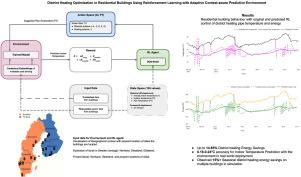District heating optimization in residential buildings using reinforcement learning with adaptive context-aware predictive environment
IF 9.6
Q1 COMPUTER SCIENCE, ARTIFICIAL INTELLIGENCE
引用次数: 0
Abstract
As district heating networks evolve to meet climate-neutral objectives, optimizing their control under heterogeneous building characteristics and dynamic environmental conditions remains a significant challenge. Traditional control strategies often lack the adaptability necessary to account for building-specific dynamics and to ensure real-time adherence to operational safety constraints. In this work, we present an integrated machine learning-based framework that combines an adaptive context-aware transformer model with deep reinforcement learning to address these limitations. The proposed approach introduces an adaptive context-aware transformer as a predictive environment within a Deep Q-Network (DQN) framework, enabling data-driven, building-specific control of district heating systems. Utilizing real-world data from 148 residential buildings across Sweden and Finland, the model incorporates contextual embeddings and temporal features to predict indoor temperature trajectories with high accuracy, achieving root mean square error values between 0.18–0.24 °C for Swedish buildings and 0.26–0.32 °C for Finnish buildings. The DQN agent leverages these predictions to optimize heating control while ensuring compliance with operational safety limits and preserving occupant comfort. Experimental results demonstrate significant energy savings, with mid-rise buildings achieving up to 14.85% reduction in energy consumption, and peak seasonal savings exceeding 20% during spring months. This integrated approach illustrates the potential for substantial energy optimization and reliable indoor climate management in future district heating networks.

基于自适应情景感知预测环境的强化学习的住宅区域供热优化
随着区域供热网络向气候中和目标的发展,在异质建筑特征和动态环境条件下优化其控制仍然是一个重大挑战。传统的控制策略通常缺乏必要的适应性,无法考虑建筑物特定的动态,也无法确保实时遵守操作安全约束。在这项工作中,我们提出了一个基于机器学习的集成框架,该框架将自适应上下文感知转换器模型与深度强化学习相结合,以解决这些限制。提出的方法引入了一个自适应的环境感知变压器,作为Deep Q-Network (DQN)框架内的预测环境,实现数据驱动的、特定于建筑的区域供热系统控制。该模型利用来自瑞典和芬兰148座住宅建筑的真实数据,结合上下文嵌入和时间特征,以高精度预测室内温度轨迹,瑞典建筑的均方根误差值为0.18-0.24°C,芬兰建筑的均方根误差值为0.26-0.32°C。DQN代理利用这些预测来优化加热控制,同时确保符合操作安全限制并保持乘员舒适度。实验结果显示节能效果显著,中层建筑能耗降低高达14.85%,春季季节节能峰值超过20%。这种综合方法说明了未来区域供热网络中大量能源优化和可靠的室内气候管理的潜力。
本文章由计算机程序翻译,如有差异,请以英文原文为准。
求助全文
约1分钟内获得全文
求助全文
来源期刊

Energy and AI
Engineering-Engineering (miscellaneous)
CiteScore
16.50
自引率
0.00%
发文量
64
审稿时长
56 days
 求助内容:
求助内容: 应助结果提醒方式:
应助结果提醒方式:


